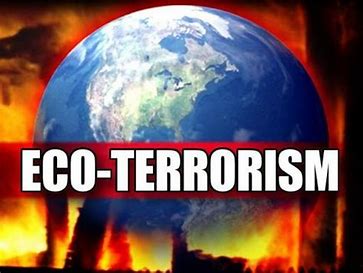Title: Unraveling Eco-Terrorism in the United States: Understanding, Impact, and Responses
Abstract:
Eco-terrorism represents a unique and controversial form of political activism that employs violence or sabotage to advance environmentalist objectives. In the United States, where environmental issues are deeply entrenched in political discourse and social movements, eco-terrorism has emerged as a divisive and polarizing phenomenon, raising questions about the boundaries of activism, the ethics of violence, and the balance between environmental protection and national security. This essay provides a comprehensive analysis of eco-terrorism in the United States, examining its origins, tactics, and consequences for society and the environment. Drawing on historical examples, case studies, and expert insights, it explores the complex dynamics of eco-terrorism, assesses the effectiveness of countermeasures, and proposes strategies for addressing environmental concerns through peaceful and lawful means.
Introduction:
Eco-terrorism, defined as the use of violence or sabotage to further
environmentalist goals, represents a contentious and multifaceted
phenomenon in the United States.
Rooted in the intersection of environmental activism, radical politics, and social justice movements, eco-terrorism challenges conventional notions of political dissent and civil disobedience, raising profound questions about the ethics of violence and the legitimacy of direct action in pursuit of environmental protection.

In the United States, where environmental issues have been at the forefront of political debate for decades, eco-terrorism has garnered significant attention from policymakers, law enforcement agencies, and the public, sparking debates over national security, civil liberties, and the balance between environmental conservation and economic development. This essay aims to provide a comprehensive examination of eco-terrorism in the United States, shedding light on its historical context, ideological underpinnings, and societal impacts. By analyzing case studies, legal frameworks, and policy responses, it seeks to deepen understanding of the complex dynamics of eco-terrorism and explore strategies for addressing environmental concerns through peaceful and lawful means.
Origins and Ideologies of Eco-Terrorism:
The origins of eco-terrorism can be traced back to the emergence of modern environmental movements in the 20th century, which sought to raise awareness of ecological issues and advocate for conservation and preservation efforts. Over time, a small faction of environmental activists adopted more radical tactics, including acts of sabotage, property destruction, and direct confrontation with authorities, in pursuit of their goals. These individuals, often associated with radical environmentalist groups such as Earth First! and the Animal Liberation Front (ALF), embraced a philosophy of “direct action” and “monkeywrenching” to disrupt industries perceived as environmentally destructive, such as logging, mining, and animal agriculture. Ideologically, eco-terrorists espouse a deep-seated belief in the intrinsic value of nature, the urgency of environmental crises, and the inadequacy of conventional political channels to address ecological concerns. While motivations vary, eco-terrorists typically view violence as a legitimate means of protest and resistance against perceived injustices perpetrated by corporations, governments, and other entities deemed responsible for environmental degradation.

Tactics and Targets of Eco-Terrorism:
Eco-terrorism encompasses a wide range of tactics and targets, reflecting the diverse motivations and objectives of its perpetrators. Some common tactics employed by eco-terrorists include:
Arson and Property Destruction:
Arson is one of the most common tactics used by eco-terrorists to inflict damage on targeted industries and infrastructure. Attacks on logging equipment, research laboratories, and construction sites are intended to disrupt operations, inflict financial losses, and raise awareness of environmental issues.
Sabotage and Vandalism:
Eco-terrorists engage in acts of sabotage and vandalism to disable or destroy machinery, equipment, and facilities associated with industries perceived as harmful to the environment. These actions may involve the use of incendiary devices, explosives, or chemical substances to cause damage and disruption.
Direct Action and Civil Disobedience:
Eco-terrorists engage in direct action protests and civil disobedience to raise awareness of environmental issues and challenge the authority of governments and corporations. Blockades, occupations, and tree-sits are common tactics used to obstruct construction projects, disrupt resource extraction activities, and draw media attention to environmental causes.
Cyber Attacks and Hacktivism:
With the proliferation of digital technologies, eco-terrorists have increasingly turned to cyber attacks and hacktivism to target corporations and government agencies engaged in environmentally harmful practices. Distributed denial-of-service (DDoS) attacks, website defacements, and data breaches are used to disrupt operations, expose sensitive information, and mobilize support for environmental campaigns.
Targets of eco-terrorism vary widely and may include:

Corporate Offices:
Eco-terrorists target corporate offices, headquarters, and facilities of companies engaged in industries such as logging, mining, oil and gas extraction, and animal agriculture. Attacks on corporate offices aim to disrupt operations, damage property, and undermine the financial viability of targeted industries.
Research Laboratories:
Laboratories engaged in scientific research and experimentation, particularly in fields such as biotechnology, genetic engineering, and animal testing, are frequently targeted by eco-terrorists. Attacks on research laboratories seek to halt or sabotage projects perceived as unethical or harmful to animals and the environment.
Government Agencies:
Government agencies responsible for environmental regulation, wildlife management, and natural resource conservation may also be targeted by eco-terrorists. Attacks on government agencies aim to protest policies perceived as detrimental to the environment and challenge the authority of regulatory authorities.
Infrastructure:
Critical infrastructure such as power plants, pipelines, and transportation networks may be targeted by eco-terrorists to disrupt operations and raise awareness of environmental risks associated with fossil fuel extraction, transportation, and consumption.
Impacts of Eco-Terrorism:
Eco-terrorism has profound consequences for society, the environment, and the political landscape, with far-reaching implications for public safety, economic stability, and civil liberties. Some of the key impacts of eco-terrorism include:
Loss of Life and Property Damage:
Eco-terrorism can result in the loss of human life, injuries, and extensive property damage, particularly in cases involving arson and explosives. Attacks on industrial facilities, research laboratories, and infrastructure pose significant risks to public safety and may lead to environmental contamination and ecological harm.

Economic Disruption:
Eco-terrorism disrupts economic activity and undermines investor confidence in industries targeted by attacks, leading to financial losses, layoffs, and disruptions to supply chains. The cost of repairing damaged property, implementing security measures, and mitigating environmental impacts can impose significant burdens on affected companies and taxpayers.
Political Polarization:
Eco-terrorism exacerbates political polarization and undermines efforts to address environmental challenges through peaceful and democratic means. Radical actions taken by eco-terrorists can alienate mainstream environmental organizations and detract from legitimate efforts to advocate for policy reforms and conservation initiatives.
Chilling Effect on Free Speech:
The use of violence and intimidation tactics by eco-terrorists can have a chilling effect on free speech and political dissent, stifling debate and discouraging individuals from exercising their right to peaceful protest. The specter of eco-terrorism may deter researchers, policymakers, and activists from engaging in public discourse on controversial environmental issues for fear of retribution.
Environmental Backlash:
Eco-terrorism risks undermining public support for environmental causes and fostering a backlash against environmental activists and organizations. The use of violence and vandalism tarnishes the reputation of the environmental movement and alienates potential allies, making it more difficult to build broad-based coalitions and mobilize support for conservation efforts.
Countermeasures and Responses to Eco-Terrorism:
Addressing the challenge of eco-terrorism requires a multifaceted approach that combines law enforcement efforts, intelligence gathering, community engagement, and targeted interventions to prevent violence and promote constructive dialogue on environmental issues. Some key countermeasures and responses to eco-terrorism include:
Law Enforcement and Prosecution:
Strengthening law enforcement capabilities to investigate and prosecute acts of eco-terrorism, including collaboration between federal, state, and local agencies to gather intelligence, track suspects, and disrupt terrorist networks. The use of undercover operations, informant networks, and surveillance techniques can help identify and apprehend individuals involved in planning or carrying out attacks.

Legislative Measures:
Enacting legislation to enhance penalties for eco-terrorism offenses, including provisions to designate eco-terrorism as a federal crime and impose harsher sentences for acts of violence, arson, and sabotage targeting critical infrastructure and national security interests. Legal measures such as the Animal Enterprise Terrorism Act (AETA) and the Critical Infrastructure Protection Act (CIPA) provide law enforcement authorities with additional tools to combat eco-terrorism and protect vulnerable targets.
Community Outreach and Engagement:
Building trust and cooperation between law enforcement agencies and local communities through community policing initiatives, outreach programs, and partnerships with environmental organizations, faith-based groups, and community leaders. Engaging with at-risk individuals and providing opportunities for constructive dialogue can help prevent radicalization and promote peaceful conflict resolution.
Intelligence Sharing and Analysis:
Enhancing information sharing and intelligence analysis capabilities to identify emerging threats, track extremist ideologies, and monitor the activities of eco-terrorist groups and individuals. Collaboration between law enforcement agencies, intelligence services, and private sector partners can help identify patterns, trends, and indicators of potential violence, enabling proactive intervention and disruption of terrorist plots.
Target Hardening and Security Measures:
Implementing security measures and risk mitigation strategies to protect vulnerable targets from eco-terrorism attacks, including physical security enhancements, perimeter fencing, surveillance cameras, and intrusion detection systems. Training personnel in threat awareness, emergency response, and crisis management can improve readiness and resilience in the face of terrorist threats.

Public Awareness and Education:
Raising public awareness of eco-terrorism threats and promoting environmental activism through peaceful and lawful means, including education campaigns, public forums, and community events. Providing accurate information about environmental issues, nonviolent protest tactics, and legal avenues for advocacy can empower individuals to engage in activism while rejecting violence and extremism.
Conclusion:
Eco-terrorism represents a complex and multifaceted challenge that requires a coordinated and comprehensive response from government agencies, law enforcement authorities, civil society organizations, and the public. By addressing the root causes of eco-terrorism, enhancing intelligence capabilities, and promoting constructive dialogue on environmental issues, the United States can work towards preventing acts of violence while safeguarding civil liberties and promoting responsible activism. While there are no easy solutions to the complex dynamics of eco-terrorism, concerted efforts to address its underlying drivers and promote peaceful conflict resolution offer hope for a safer, more sustainable future for all.


